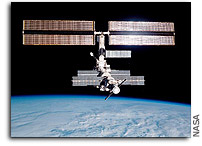ISS Status Report #34 Aug. 2, 2002
 Commander Valery Korzun, Astronaut Peggy Whitson and Cosmonaut Sergei Treschev completed their eighth week aboard the International Space Station, conducting scientific research, maintenance work and daily exercise routines.
Commander Valery Korzun, Astronaut Peggy Whitson and Cosmonaut Sergei Treschev completed their eighth week aboard the International Space Station, conducting scientific research, maintenance work and daily exercise routines.
Scientific research in the Destiny lab this week focused on the Advanced Astroculture (ADVASC) and Solidification Using Baffle in Sealed Ampoules (SUBSA) experiments. The ADVASC plant growth chamber houses the first soybean plant growth experiment ever conducted in space. Photographs taken by Whitson show that the plants have developed flowers and seedpods. Tuesday Whitson performed the third nutrient exchange and gas sample procedure for the experiment. This microgravity research may result in soybeans with improved oil, protein, or carbohydrate content, as well as the secondary metabolites, such as phytoestrogen, of commercial value.
The SUBSA experiment, isolated inside the Microgravity Science Glovebox (MSG), is testing what causes motion in the melted fluids used to create semiconductors and a way to reduce the magnitude of that motion, potentially leading to a reduction in defects in semiconductors in space and on Earth. Wednesday ground controllers at the Payload Operations Center at the Marshall Space Flight Center in Huntsville, Ala., sent a software patch to the MSG system to increase the allowed temperature of a furnace inside the box. The SUBSA samples are heated to their 1,490 degrees Fahrenheit (810 degrees Celsius) melting point. After a successful test run of the empty MSG, Whitson loaded the third set of samples into the experiment Thursday.
The crewmembers began a modified exercise routine this week after engineers decided they should not use the Treadmill Vibration Isolation System until it can be fixed. Investigations by the crew found a problem with one of the many rollers that the treadmill’s belt runs along. A ball bearing for the rod supporting the roller has seized and the rod has rubbed against the frame of the treadmill. Engineers are working to develop a procedure and hardware to fix the treadmill that could be sent to the station on the next Progress resupply vehicle in September. The crew can use other various machines onboard including a cycle ergometer and a resistive exercise devise.
Korzun and Treschev worked on a procedure to bring the oxygen-generating Elektron system back to its full capabilities. The Elektron separates water into its oxygen and hydrogen components, venting the oxygen into the cabin for the crew to breathe and sending the hydrogen overboard. The original liquid unit in the system experienced a problem in April and the crew replaced it with a backup unit that has had to run in a manual mode requiring the crew to activate its valves. This week, the crew returned the original liquid unit into the Elektron, but that did not bring the system back online. The crew replaced the original with the backup unit again, restoring manual mode operations.
Operations to test the Mobile Servicing System were partially completed Thursday. Korzun and Whitson maneuvered the space station robotic arm, Canadarm2, into a position enabling cameras to look back on its Mobile Base System and the attached Payload Orbital Replacement Unit Accommodation (POA) grapple fixture. The POA was commanded to go through the motions of grasping a payload while cameras on the end of the robotic arm watched. During a test, the computer software thought the POA motors were running too quickly and put the robotic system in a safe mode. Flight controllers turned the POA on and off and restored Canadarm2’s motion. A test run with the motors operating more slowly was successful and the arm was left in place until it will be moved next week into a position to use its cameras to view the first Expedition 5 spacewalk. The remaining checkout procedures will be rescheduled.
Korzun and Whitson will step outside of the Russian Pirs docking compartment and airlock Aug. 16 to install panels designed to protect the Zvezda service module from space debris, as well as a new set of Russian materials samples to be exposed to the harsh conditions of space. Live coverage of the spacewalk will begin on NASA Television at 2 a.m. CDT. Korzun and Treschev will make another spacewalk starting late Aug. 22, installing similar materials samples in a Japanese experiment and two additional amateur radio antennas.
The Progress spacecraft’s engines boosted the station by about 5 statute miles to an average altitude of 246 statute miles Thursday. This sets the stage for the arrival of a new Progress and a Soyuz taxi crew, both scheduled to launch from the Baikonur Cosmodrome in Kazakhstan this fall.
Information on the crew’s activities aboard the space station, future launch dates, as well as station sighting opportunities from anywhere on the Earth, is available on the Internet at:
Details on station science operations can be found on an Internet site administered by the Payload Operations Center at NASA’s Marshall Space Flight Center in Huntsville, Ala., at:
http://www.scipoc.msfc.nasa.gov
The next ISS status report will be issued on Friday, Aug. 9, or sooner if events warrant.









